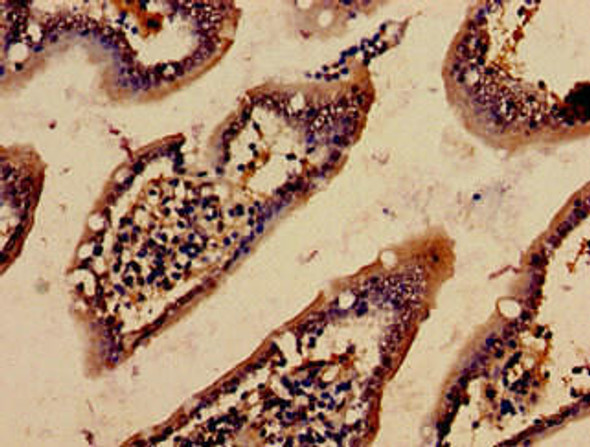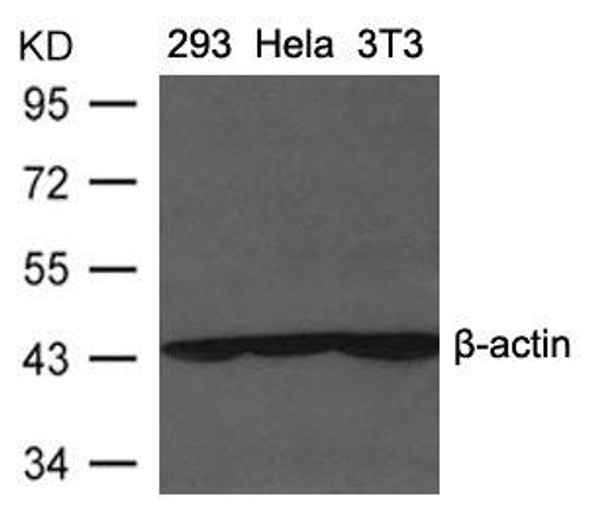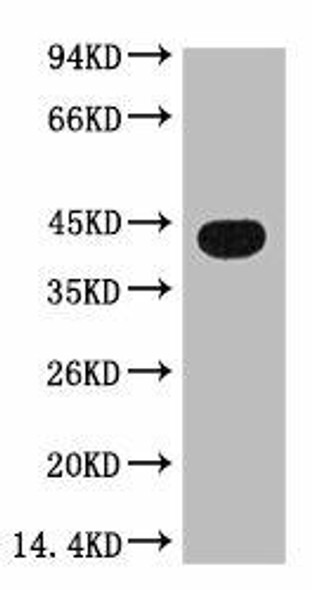Description
ACTB Antibody (PACO28698)
The ACTB Polyclonal Antibody (PAC028698) is a valuable tool for researchers studying ACTB, also known as beta-Actin, a highly conserved protein involved in cell structure and motility. This antibody, generated in rabbits, is highly specific to human samples and has been validated for use in Western blot applications. It binds specifically to the ACTB protein, allowing for accurate detection and analysis in a variety of cell types, making it an ideal choice for studies in cell biology, cancer research, and more.
ACTB is a crucial component of the cytoskeleton, playing a key role in cell shape and movement. Its involvement in cell migration, adhesion, and signaling pathways makes it a target of interest for researchers investigating these processes in normal and diseased states. By understanding the functions and regulation of ACTB, researchers can gain insights into various physiological and pathological conditions, paving the way for potential therapeutic interventions.
| Antibody Name: | ACTB Antibody (PACO28698) |
| Antibody SKU: | PACO28698 |
| Size: | 50ug |
| Host Species: | Rabbit |
| Tested Applications: | ELISA, WB, IHC, IF |
| Recommended Dilutions: | ELISA:1:2000-1:10000, WB:1:1000-1:5000, IHC:1:100-1:1000, IF:1:50-1:200 |
| Species Reactivity: | Human |
| Immunogen: | Recombinant Human Actin, cytoplasmic 1 protein (102-375AA) |
| Form: | Liquid |
| Storage Buffer: | Preservative: 0.03% Proclin 300 Constituents: 50% Glycerol, 0.01M PBS, PH 7.4 |
| Purification Method: | >95%, Protein G purified |
| Clonality: | Polyclonal |
| Isotype: | IgG |
| Conjugate: | Non-conjugated |
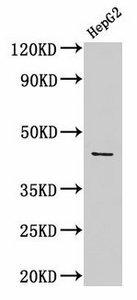 | Western Blot Positive WB detected in: HepG2 whole cell lysate All lanes: ACTB antibody at 1:1000 Secondary Goat polyclonal to rabbit IgG at 1/50000 dilution Predicted band size: 42 kDa Observed band size: 42 kDa . |
 | IHC image of PACO28698 diluted at 1:500 and staining in paraffin-embedded human small intestine tissue performed on a Leica BondTM system. After dewaxing and hydration, antigen retrieval was mediated by high pressure in a citrate buffer (pH 6.0). Section was blocked with 10% normal goat serum 30min at RT. Then primary antibody (1% BSA) was incubated at 4°C overnight. The primary is detected by a biotinylated secondary antibody and visualized using an HRP conjugated SP system. |
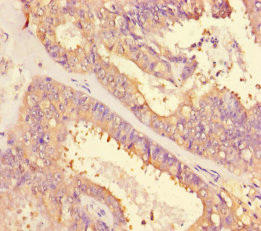 | Immunohistochemistry of paraffin-embedded human endometrial cancer using PACO28698 at dilution of 1:100. |
| Background: | Actins are highly conserved proteins that are involved in various types of cell motility and are ubiquitously expressed in all eukaryotic cells. |
| Synonyms: | Actin, cytoplasmic 1 (Beta-actin) [Cleaved into: Actin, cytoplasmic 1, N-terminally processed], ACTB |
| UniProt Protein Function: | Function: Actins are highly conserved proteins that are involved in various types of cell motility and are ubiquitously expressed in all eukaryotic cells. |
| UniProt Protein Details: | Subunit structure: Polymerization of globular actin (G-actin) leads to a structural filament (F-actin) in the form of a two-stranded helix. Each actin can bind to 4 others. Identified in a mRNP granule complex, at least composed of ACTB, ACTN4, DHX9, ERG, HNRNPA1, HNRNPA2B1, HNRNPAB, HNRNPD, HNRNPL, HNRNPR, HNRNPU, HSPA1, HSPA8, IGF2BP1, ILF2, ILF3, NCBP1, NCL, PABPC1, PABPC4, PABPN1, RPLP0, RPS3, RPS3A, RPS4X, RPS8, RPS9, SYNCRIP, TROVE2, YBX1 and untranslated mRNAs. Component of the BAF complex, which includes at least actin (ACTB), ARID1A, ARID1B/BAF250, SMARCA2, SMARCA4/BRG1, ACTL6A/BAF53, ACTL6B/BAF53B, SMARCE1/BAF57 SMARCC1/BAF155, SMARCC2/BAF170, SMARCB1/SNF5/INI1, and one or more of SMARCD1/BAF60A, SMARCD2/BAF60B, or SMARCD3/BAF60C. In muscle cells, the BAF complex also contains DPF3. Found in a complex with XPO6, Ran, ACTB and PFN1. Component of the MLL5-L complex, at least composed of MLL5, STK38, PPP1CA, PPP1CB, PPP1CC, HCFC1, ACTB and OGT. Interacts with XPO6 and EMD. Interacts with ERBB2. Interacts with GCET2. Ref.11 Ref.12 Ref.15 Ref.22 Subcellular location: Cytoplasm cytoskeleton. Note: Localized in cytoplasmic mRNP granules containing untranslated mRNAs. Ref.17 Post-translational modification: ISGylated. Ref.13Oxidation of Met-44 by MICALs (MICAL1, MICAL2 or MICAL3) to form methionine sulfoxide promotes actin filament depolymerization. Methionine sulfoxide is produced stereospecifically, but it is not known whether the (S)-S-oxide or the (R)-S-oxide is produced By similarity. Involvement in Disease: Defects in ACTB are a cause of dystonia juvenile-onset (DYTJ) [ MIM:607371]. DYTJ is a form of dystonia with juvenile onset. Dystonia is defined by the presence of sustained involuntary muscle contraction, often leading to abnormal postures. DYTJ patients manifest progressive, generalized, dopa-unresponsive dystonia, developmental malformations and sensory hearing loss. Ref.23Defects in ACTB are the cause of Baraitser-Winter syndrome type 1 (BRWS1) [ MIM:243310]. A rare developmental disorder characterized by the combination of congenital ptosis, high-arched eyebrows, hypertelorism, ocular colobomata, and a brain malformation consisting of anterior-predominant lissencephaly. Other typical features include postnatal short stature and microcephaly, intellectual disability, seizures, and hearing loss. Ref.25 Miscellaneous: In vertebrates 3 main groups of actin isoforms, alpha, beta and gamma have been identified. The alpha actins are found in muscle tissues and are a major constituent of the contractile apparatus. The beta and gamma actins coexist in most cell types as components of the cytoskeleton and as mediators of internal cell motility. Sequence similarities: Belongs to the actin family. |
| NCBI Summary: | This gene encodes one of six different actin proteins. Actins are highly conserved proteins that are involved in cell motility, structure, and integrity. This actin is a major constituent of the contractile apparatus and one of the two nonmuscle cytoskeletal actins. [provided by RefSeq, Jul 2008] |
| UniProt Code: | P60709 |
| NCBI GenInfo Identifier: | 46397333 |
| NCBI Gene ID: | 60 |
| NCBI Accession: | P60709.1 |
| UniProt Secondary Accession: | P60709,P02570, P70514, P99021, Q11211, Q64316, Q75MN2 Q96B34, Q96HG5, |
| UniProt Related Accession: | P60709 |
| Molecular Weight: | 67 KD |
| NCBI Full Name: | Actin, cytoplasmic 1 |
| NCBI Synonym Full Names: | actin, beta |
| NCBI Official Symbol: | ACTB |
| NCBI Official Synonym Symbols: | BRWS1; PS1TP5BP1 |
| NCBI Protein Information: | actin, cytoplasmic 1; beta cytoskeletal actin; PS1TP5-binding protein 1 |
| UniProt Protein Name: | Actin, cytoplasmic 1 |
| UniProt Synonym Protein Names: | Beta-actin |
| Protein Family: | Actin |
| UniProt Gene Name: | ACTB |
| UniProt Entry Name: | ACTB_HUMAN |
| Secondary Antibody |
| Anti-HRP Goat Anti-Rabbit IgG (H+L) Antibody (CABS014) |
| Recommended Products |
| Anti-FITC Goat Anti-Rabbit IgG (H+L) Antibody (CABS011) |
| Anti-HRP-conjugated Beta Actin Antibody (CABC028) |







